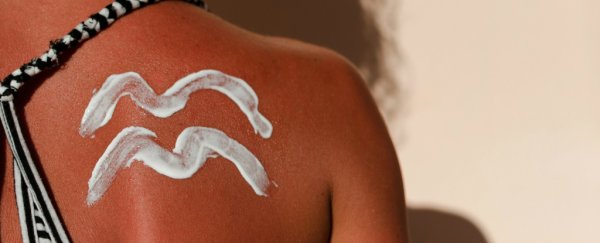A new study has found that most of us are putting on sunscreen wrong, and are only getting 40 percent of the SPF protection we think we are.
While it's common knowledge that you need to cover all exposed skin in sunscreen, the study shows that most of us don't coat it on anywhere near thick enough.
When the very first sunscreen product was marketed in the mid-nineteenth century, it provided a sun protection factor (SPF) of just 2. Six decades later, and scientists have created water-resistant sunscreen, spray sunscreen, long-lasting sunscreen and sunscreens with SPF all the way up to 100.
But while the technology behind sun protection has come a long way, the effectiveness of sunscreen is highly dependent on how it is applied. And for more than 60 years, most of us have been putting on that goopy cream incorrectly.
Now, for the very first time, researchers from King's College London have revealed that when sunscreen is applied in the typical way, it bestows only 40 percent of the product's expected SPF, putting our skin at risk.
"People are typically getting much less protection than they think," author of the study, Antony Young, a professor of experimental photobiology at King's College London, told The Guardian.
"For example, if you get SPF20 and use at a lower thickness of 0.75 milligrams per centimetre squared, your level of protection could be as low as SPF4."
A better thickness is around 2 mg of sunscreen per centimetre squared - which is a little hard to imagine, but is often more than double the amount most people spread on.
Most skin cancers are caused by DNA damage from UV radiation (UVR), which means that sun protection has important implications for public health.
When it comes to protecting skin from cancer, many experts have pointed out that the difference between SPF 50 sunscreen and SPF 100 sunscreen is negligible.
But the new study reveals that this is only true when the sunscreen is properly applied - something that does not happen nearly enough.
Previous studies have shown that most people apply about a third of the recommended sunscreen dosage (2 milligrams of sunscreen for every square centimetre of skin). This is a problem, because, as the new study reveals, SPF is directly tied to sunscreen application thickness.
Take SPF 50 sunscreen, for example. Theoretically, this level of SPF should protect someone from 98 percent of UVB rays. But if a sufficient amount is not applied, the new study suggests users will be reaping less than half of the sun protection benefits that the product promises.
So while choosing a high SPF sunscreen may seem like overkill, in reality, it's probably your best bet against sun damage.
"This research demonstrates why it's so important to choose an SPF of 30 or more," says Nina Goad from the British Association of Dermatologists.
"In theory, an SPF of 15 should be sufficient, but we know that in real-world situations, we need the additional protection offered by a higher SPF."
To measure the real-world effectiveness of sunscreen, the study mimicked what an actual holiday in the sun might be like. As a result, conditions were based on popular vacation destinations, like Tenerife, Florida and Brazil.
The volunteers were split into two groups with three women and five men in each.
One group received a single exposure to UVR in areas with varying thicknesses of sunscreen applied.
The other group received five consecutive days of UVR exposure, although each day the level of exposure and the amount of sunscreen used was slightly different.
Unsurprisingly, when the researchers biopsied the areas exposed to UVR in the second group, they found considerable DNA damage when sunscreen was not applied.
But they also showed that the amount of sunscreen applied made a big difference. Damage was reduced slightly when sunscreen was applied at a low thickness of 0.75 mg per centimetre squared.
But DNA damage was considerably reduced when people slopped on 2 mg per centimetre squared - even in the group that was exposed to more UVR.
All in all, the study involved 16 volunteers with fair skin types that are particularly sensitive to the Sun. And while that is certainly a small sample size, the findings show a high level of significance.
The results confirm what appears to be a logical conclusion: when sunscreen is applied at thicker levels, it considerably reduces your chances of sun damage.
This part of the study is not particularly shocking. Previous studies have shown that even low levels of UVR exposure can still lead to skin damage, and most of us know this to be true anecdotally.
What is surprising, however, is the extent to which a once-off, low dose of UVR exposure can damage your skin.
The results show that five days of exposure to a high dose of UVR with sunscreen is significantly less damaging than just one day of low UVR exposure without sunscreen. This pattern was seen across all samples.
"There is no dispute that sunscreen provides important protection against the cancer-causing impact of the sun's ultra violet rays," says Young.
"However, what this research shows is that the way sunscreen is applied plays an important role in determining how effective it is."
The authors of the study warn that sunscreen on its own is often insufficient, and they suggest doubling up with a hat or seeking out shade whenever possible.
The study has been published in Acta Dermato-Venereologica.
